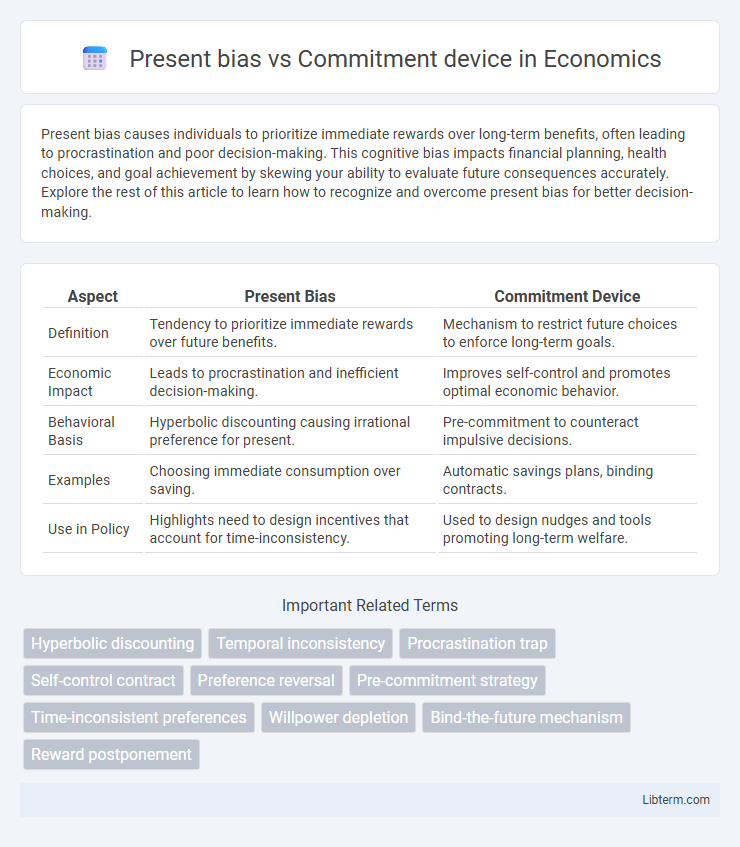Present bias causes individuals to prioritize immediate rewards over long-term benefits, often leading to procrastination and poor decision-making. This cognitive bias impacts financial planning, health choices, and goal achievement by skewing your ability to evaluate future consequences accurately. Explore the rest of this article to learn how to recognize and overcome present bias for better decision-making.
Table of Comparison
| Aspect | Present Bias | Commitment Device |
|---|---|---|
| Definition | Tendency to prioritize immediate rewards over future benefits. | Mechanism to restrict future choices to enforce long-term goals. |
| Economic Impact | Leads to procrastination and inefficient decision-making. | Improves self-control and promotes optimal economic behavior. |
| Behavioral Basis | Hyperbolic discounting causing irrational preference for present. | Pre-commitment to counteract impulsive decisions. |
| Examples | Choosing immediate consumption over saving. | Automatic savings plans, binding contracts. |
| Use in Policy | Highlights need to design incentives that account for time-inconsistency. | Used to design nudges and tools promoting long-term welfare. |
Understanding Present Bias
Present bias refers to the tendency to prioritize immediate rewards over long-term benefits, leading individuals to make choices that favor short-term gratification despite future costs. Commitment devices are strategies or tools designed to counteract present bias by locking in future behavior, thus aligning actions with long-term goals. Understanding present bias is crucial for developing effective commitment devices that improve decision-making and promote delayed gratification.
Defining Commitment Devices
Commitment devices are strategies or tools designed to help individuals overcome present bias by restricting their future choices to align with long-term goals. These mechanisms include automatic savings plans, deadlines, or penalties that create incentives for maintaining self-control. By limiting the temptation to prioritize immediate rewards, commitment devices promote consistent progress toward future objectives.
Psychological Roots of Present Bias
Present bias stems from humans' tendency to overvalue immediate rewards over future benefits, rooted in psychological mechanisms like hyperbolic discounting and impulsivity. This cognitive bias causes individuals to make choices favoring short-term gratification despite long-term costs. Commitment devices leverage this understanding by creating external constraints that help individuals align behavior with future goals and counteract present bias.
How Commitment Devices Counter Present Bias
Commitment devices effectively counter present bias by restricting future choices and incentivizing long-term goals, reducing the temptation to prioritize immediate gratification. By pre-committing to actions or penalties, such as automatic savings plans or deadlines, individuals enhance self-control and align behavior with future benefits. This mechanism leverages commitment to overcome the cognitive distortion of undervaluing future rewards characteristic of present bias.
Real-World Examples of Present Bias
Present bias often causes individuals to prioritize immediate rewards over long-term benefits, leading to behaviors like procrastination or undersaving for retirement. For instance, many people opt for fast food despite knowing the health consequences, illustrating a preference for instant gratification. Commitment devices like automatic savings plans or gym memberships with penalties help counteract this bias by locking individuals into actions that benefit their future selves.
Types of Commitment Devices
Present bias leads individuals to favor immediate rewards over long-term benefits, often hindering goal achievement, which commitment devices counteract by locking in future actions. Types of commitment devices include financial commitments, such as deposits forfeited if goals aren't met; social commitments involving public accountability to leverage social pressure; and behavioral commitments that modify the environment or routine to reduce temptation. Each type harnesses different psychological mechanisms to overcome present bias and improve adherence to long-term objectives.
Benefits of Using Commitment Devices
Commitment devices help individuals overcome present bias by locking in future actions that align with long-term goals, reducing impulsive decisions. These tools increase accountability and motivation by creating tangible consequences for deviation, enhancing self-control. Using commitment devices leads to improved goal attainment, such as saving more money or maintaining healthier habits.
Present Bias in Everyday Decision-Making
Present bias causes individuals to disproportionately favor immediate rewards over long-term benefits, often leading to procrastination and suboptimal choices in daily life. This cognitive bias explains why people delay important tasks such as saving money, exercising, or healthy eating despite understanding future advantages. Commitment devices serve as tools to counteract present bias by restricting future choices and encouraging adherence to long-term goals.
Designing Effective Commitment Strategies
Present bias causes individuals to prioritize immediate rewards over long-term benefits, often leading to procrastination and suboptimal decision-making. Designing effective commitment strategies involves creating binding mechanisms such as automatic savings plans, pre-commitment contracts, or goal-tracking apps that restrict future choices and align actions with long-term objectives. Incorporating elements like deadlines, penalties for lapses, and social accountability enhances the efficacy of commitment devices in counteracting present bias and promoting consistent progress toward goals.
Overcoming Present Bias for Long-Term Success
Present bias causes individuals to prioritize immediate rewards over long-term benefits, often leading to procrastination and poor decision-making. Commitment devices act as strategic tools that lock in future behaviors, reducing the temptation to deviate from long-term goals. Utilizing commitment devices effectively helps overcome present bias, fostering sustained progress and improved self-control for long-term success.
Present bias Infographic

 libterm.com
libterm.com